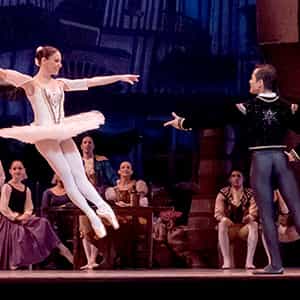

The Rite of Spring Tickets
No Buyer Fees on The Rite of Spring Tickets and Up to 30% Off Compared to Competitors. Learn More →
Select Location (e.g, New York)
Events Nearby
Frequently Asked Questions About The Rite of Spring Tickets and Events
What is the significance of The Rite of Spring in the world of ballet and music?
The Rite of Spring, composed by Igor Stravinsky, is considered a groundbreaking work that revolutionized 20th-century music and dance. Its innovative use of rhythm, dissonance, and orchestration challenged traditional conventions and sparked a new direction in the performing arts.
Who are some of the notable choreographers that have created interpretations of The Rite of Spring?
Various renowned choreographers have created their interpretations of The Rite of Spring, including Vaslav Nijinsky, who premiered the ballet in 1913, as well as contemporary figures like Pina Bausch and Wayne McGregor, each bringing their unique vision to this iconic piece.
What themes are explored in The Rite of Spring?
The Rite of Spring explores themes of pagan rituals, the cycle of life and death, and the relationship between humanity and nature. It portrays the tension between the ancient and the modern, culminating in a powerful narrative about sacrifice and renewal.
How has The Rite of Spring influenced modern dance and choreography?
The Rite of Spring has had a profound influence on modern dance, inspiring choreographers to experiment with movement, structure, and narrative. Its emphasis on raw emotion, physicality, and innovative use of space has paved the way for contemporary dance forms.
What are some key musical characteristics of The Rite of Spring?
Key musical characteristics of The Rite of Spring include irregular rhythms, complex orchestration, and the use of dissonance. Stravinsky's innovative approach to meter and his bold harmonic language create a sense of primal energy and intensity throughout the work.
How has The Rite of Spring been received by audiences and critics over the years?
Initially met with controversy and outrage at its premiere due to its avant-garde nature, The Rite of Spring has since become a celebrated masterpiece. Over the years, it has been re-evaluated and is now regarded as a pivotal work in the history of music and dance.
What role does the orchestra play in The Rite of Spring?
In The Rite of Spring, the orchestra plays a crucial role, serving not just as an accompaniment but as an integral part of the storytelling. Stravinsky's orchestration employs a wide range of instruments and textures, creating vivid soundscapes that enhance the dramatic narrative of the ballet.
What impact did the premiere of The Rite of Spring have on the arts community?
The premiere of The Rite of Spring in 1913 caused a significant stir in the arts community, leading to riots and heated debates. This event highlighted the tensions between traditional and modern artistic expressions, marking a turning point in the acceptance of avant-garde art forms.
How can I prepare for a performance of The Rite of Spring?
To prepare for a performance of The Rite of Spring, it can be helpful to familiarize yourself with the music and choreography beforehand. Watching previous performances, reading about its historical context, and understanding its themes can enhance your appreciation and enjoyment of the work.
What are some common misconceptions about The Rite of Spring?
Common misconceptions about The Rite of Spring include the belief that it is solely a ballet focused on violence and chaos. While these elements are present, the work is also deeply rooted in themes of ritual, community, and the beauty of nature's cycles.

